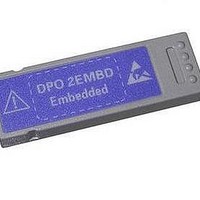DPO2EMBD Tektronix, DPO2EMBD Datasheet - Page 3

DPO2EMBD
Manufacturer Part Number
DPO2EMBD
Description
Benchtop Oscilloscopes Embd. serial trigger and analysis module
Manufacturer
Tektronix
Type
Embedded Serial Triggering and Analysis Moduler
Datasheet
1.ACD2000.pdf
(11 pages)
Specifications of DPO2EMBD
Equipment Type
Module
Sampling Rate
1 GS/s
Sweep
1 X / 10 X
Bandwidth
200 MHz
Display Type
TFT-LCD Color
Used With
MSO2000 and DPO2000 Series Oscilloscopes
Lead Free Status / RoHS Status
Lead free / RoHS Compliant
MSO/DPO2000 triggered on a specific data packet going across an I
edges and 1s and 0s. A Bus waveform provides decoded packet content including Start, Address,
Read/Write, Data, and Stop. And the addition of timing waveforms makes it easy to quickly determine
values of two signals.
See the MSO/DPO2000
Series in action for yourself.
Try out the MSO/DPO2000
Virtual Oscilloscope at:
www.tektronix.com/mso2000
Serial Triggering and Analysis
One of the most common applications
requiring long record length is serial data
analysis in embedded system design.
Embedded systems are virtually every-
where. They can contain many different
types of devices including microproces-
sors, microcontrollers, DSPs, RAM,
EEPROMs, FPGAs, ADCs, DACs, and
I/O. These various devices have tradi-
tionally communicated with each other
and the outside world using wide parallel
buses. Today, however, more and more
embedded systems are replacing these
wide parallel buses with serial buses
due to lower board space requirements,
fewer pins, lower power, embedded
clocks, differential signaling for better
noise immunity and most importantly,
lower cost. In addition, there’s a large
supply of off-the-shelf building block
components from reputable manufac-
turers, enabling rapid design development.
While serial buses have a large number
of benefits, they also present significant
challenges that their predecessors (parallel
buses) did not face.They make debug-
ging bus and system problems more
Digital Phosphor Oscilloscopes • www.tektronix.com/mso2000 • www.tektronix.com/dpo2000
difficult, it’s harder to isolate events of
interest and it’s more difficult to interpret
what is displayed on the oscilloscope
screen. The MSO2000 and DPO2000
Series address these challenges and
represent the ultimate tool for engi-
neers working with serial buses such
as I
CAN, and LIN.
Bus Display - Provides a higher level,
combined view of the individual signals
(clock, data, chip enable, etc.) that make
up your bus, making it easy to identify
where packets begin and end and
identifying sub-packet components such
as address, data, identifier, CRC, etc.
Serial Triggering - Trigger on packet
content such as start of packet, specific
addresses, specific data content, unique
identifiers, etc., on popular serial inter-
faces - I
CAN, and LIN.
Bus Decoding - Tired of having to
visually inspect the waveform to count
clocks and determine if each bit is a 1
or a 0, and then combine bits into bytes
and determine the hex value? Let the
oscilloscope do it for you! Once you’ve
set up a bus, the oscilloscope will decode
each packet on the bus and display the
value in either hex, binary, decimal (LIN
only), or ASCII (RS-232/422/485/UART
only) in the bus waveform.
2
C, SPI, RS-232/422/ 485/UART,
2
C, SPI, RS-232/422/485/UART,
2
C bus. No more counting clock
Event Table - In addition to seeing
decoded packet data on the bus wave-
form itself, you can view all captured
packets in a tabular view much like you
would see on a logic analyzer. Packets
are time-stamped and listed consecu-
tively with columns for each component
(Address, Data, etc.). The event table
can also be exported for use offline.
Search - Serial triggering is very useful
for isolating an event of interest, but
once you’ve captured it and need to
analyze the surrounding data, what do
you do? In the past, you had to manually
scroll through the waveform, counting
and converting bits and looking for what
caused the event. With the MSO2000
and DPO2000 Series, you can have the
oscilloscope automatically search through
the acquired data for user-defined criteria
including serial packet content. Each
occurrence is marked for easy reference.
Rapid navigation between marks is as
simple as pressing the Previous (
Next (
Mixed Signal Design and Analysis
(MSO2000 Series)
As an embedded-design engineer, you
are faced with the challenge of ever-
increasing system complexity. A typical
embedded design may incorporate
various analog signals, high- and low-
speed serial digital communication and
microprocessor buses, just to name a
few. Serial protocols such as I
SPI are used frequently for chip-to-chip
communication, but parallel buses are
still used in many applications.
Digital Phospor Oscilloscopes
The P6316 digital probe for MSO2000 Series
simplifies connection to the device-under-test
MSO2000 Series • DPO2000 Series
) buttons on the front panel.
2
C and
) and
3










